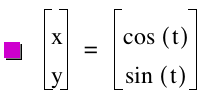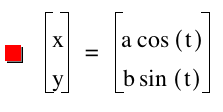

Assignment 10
by
Allison McNeece
For this assignment we will be looking at parametric equations.
A parametric curve in the plane is a pair of functions. x=f(t) and y=f(t) where f(t) is a function of time.
The two continuous functions define ordered pairs (x,y) and are called parametric equations of a curve.
The extent of the curve will depend on the range of t.
For example let's look at the following equations:

Allowing t to range from 0 to π we get:
|
But if we allow t to rangle from 0 to 2π then we get:
|
What if we changed up these equations a bit?
Let's graph the following with different values for a and b and 0 < t < 2π

with a=1 and b=1
|
with a=2 and b=1
|
with a=1 and b=2
|
So this gives us the intuition that if a>b then our graph will be stretched out horizontally but if b>a then our graph will be stretched out vertically.
What if we manipulated the values of what we are taking the sine and cosine of?
Let's first place an n infront of the t in the cosine function and see what the graph looks like for different values of n:
(a=b=1 and 0<t<2π)
n is odd |
n is even |
|---|---|
|
n=1
|
n=2
|
n=3
|
n=4
|
n=5
|
n=6
|
n=7
|
n=8
|
n=9
|
n=10
|
So we find that there is a difference when n is even or odd. Well let's think about this, what do we know about cosine?
cos(π) = -1
cos(2π) = 1
Let's try this again but let's place an n infront of the t in the sine funtion:
/n-value of sine.png)
(a=b=1 and 0<t<2π)
n is odd |
n is even |
|---|---|
n=1
|
n=2
|
n=3
|
n=4
|
n=5
|
n=6
|
n=7
|
n=8
|
n=9
|
n=10
|
We don't see the difference between even and odd values that we saw when looking at the cosine values.
What do we know about the sine function?
sin(π) = 0
sin(2π) = 0